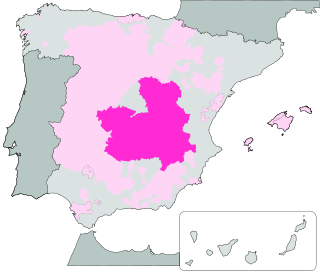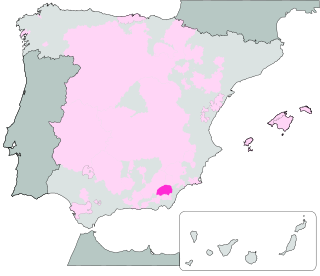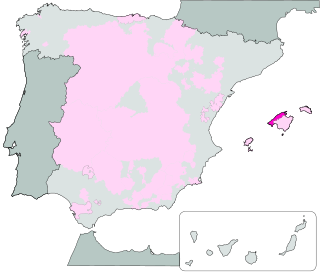External links
| ||||||||||||||||||||||||||||||||||
39°27′0″N4°24′0″W / 39.45000°N 4.40000°W / 39.45000; -4.40000
| Wine region | |
| Type | Vino de Pago |
|---|---|
| Country | Spain |
Dehesa del Carrizal is a Vino de Pago from Spain. This is the highest category on the quality scale of Spanish wines and means that in addition to having a proven track record of consistent quality, the wines have to be both produced from estate-grown grapes and also have to be processed and aged in a winery (bodega) located on the estate.
This Vino de Pago is located in Retuerta del Bullaque in the region of the Montes de Toledo, in the Province of Ciudad Real, Spain,
The first vineyard was planted back in 1987. Today the vineyard surface is about 28 hectares. Grape varieties planted are Cabernet Sauvignon, Syrah, Merlot, Petit Verdot, Tempranillo and Chardonnay. Its Cabernet Sauvignon is well known as one of the finest Cabernets ever made in Spain. As well as its Chardonnay.
Dehesa del Carrizal belongs to "Grandes Pagos de España" association.
It is the mountain range running east to west within the provinces of Toledo and Ciudad Real, between the topographical depressions of Tajo and Guadiana.
Many years went before these lands’ great ecological and landscape wealth was recognized, with two key dates in its history: 1885 marks the beginning of Madoz disentailment (where Dehesa del Carrizal is first named), and 1995 sees the declaration of Cabañeros National Park.
Bioclimatically and biogeographically the area is defined as siliceous Mediterranean mountains of the Southern Plateau, making it a rare mountainous configuration, very different from the neighbouring regions of Toledan Plateau (North), La Mancha (East), and Campo de Calatrava (South). Acidic soils, a more humid climate and its altitude (between 600 m in the hillsides to 1,400 m in the mountain tops) distinguish the region and the wines it produces.
In this natural environment, rich in botanical species and fauna, the first viticulture project of the Montes de Toledo was born in 1987 with the planting of 8 acres of Cabernet-Sauvignon vines, in Dehesa del Carrizal. These first 8 acres have become 28 today, where next to Cabernet-Sauvignon now grow Syrah, Merlot, Tempranillo, Petit Verdot and Chardonnay, all of them in the surroundings of the winery, and which in 2006 have been recognized with their own official Vino de Pago (then Denominación de Origen de Pago) designation.
The vineyards lay over a “raña” (local name for the hillsides at the foot of the Montes) composed of accumulated clay and quartzite pebble, formed from the mountain summit’s erosion during the Tertiary era. It is situated between 800 and 900 meters of altitude, north orientation. The vineyard is conducted in espaliers, with drip support irrigation. The unique climate of the region brings an average of 700 mm of rain per year, which together with the predominant thermic inversion causes slow and full ripenings, harvesting in some cases by November.
Vinification, aging and bottling is all done in the winery, in a 1999 building next to the vineyard. The winery has all the necessary facilities for high quality production: gravity barreling, temperature-controlled stainless steel tanks, air-conditioned warehouses for barrel and bottle aging, etc.
The production building is partially buried in the mountain, its front facing the social areas built in classic Moorish brick. The main room enjoys a large fireplace and can fit 100 people.
Dominio de Valdepusa is a Vino de Pago from Spain. This is the highest category on the quality scale of Spanish wines and means that in addition to having a proven track record of consistent quality, the wines have to be both produced from estate-grown grapes and also have to be processed and aged in a winery (bodega) located on the estate. This Vino de Pago is located in the municipality of Malpica de Tajo, in the province of Toledo and acquired its status in 2003.

Valdepeñas is a Spanish Denominación de Origen Protegida (DOP) for wines located in the province of Ciudad Real in the south of Castile-La Mancha (Spain). It is almost completely surrounded by another DOP but is an independent DOP due to its long history of producing a distinct style of wine known aloque or clarete which is made by mixing white and red grapes. 2016´s harvest is formed from 55.9 million kilograms of red grapes and 43.2 million kilograms of white grapes.
Guijoso is a Vino de Pago from Spain. This is the highest category on the quality scale of Spanish wines and means that in addition to having a proven track record of consistent quality, the wines have to be both produced from estate-grown grapes and also have to be processed and aged in a winery (bodega) located on the estate.
Finca Élez is a Vino de Pago from Spain. This is the highest category on the quality scale of Spanish wines and means that in addition to having a proven track record of consistent quality, the wines have to be both produced from estate-grown grapes and also have to be processed and aged in a winery (bodega) located on the estate. This Vino de Pago is located in the municipality of El Bonillo, in the province of Albacete and acquired its status in 2002.

Pago de Otazu is a branch of Bodega Otazu, a Spanish winery in Navarre, Spain. The Pago de Otazu branch uses the Vino de Pago wine appellation, a classification for Spanish wine applied to individual vineyards or wine estates, unlike the Denominación de Origen Protegida (DOP) or Denominación de Origen Calificada (DOCa) which is applied to an entire wine region. This Vino de Pago is located in the municipality of Echauri, a village only 8 km from Pamplona, the capital of the Foral Community of Navarra, Spain, and it is geographically within the borders of the Navarra DOP. The winery, Bodega Otazu, also sells wines under the Navarra DOP appellation.

Pago Irache is a branch of Bodegas Irache, a Spanish winery in Navarre, Spain. The Pago Irache branch uses the Vino de Pago wine appellation, a classification for Spanish wine applied to individual vineyards or wine estates, unlike the Denominación de Origen Protegida (DOP) or Denominación de Origen Calificada (DOCa) which is applied to an entire wine region. This Vino de Pago is located in the municipality of Aberin, in the Foral Community of Navarra, Spain, and is geographically within the borders of the Navarra DOP. This Vino de Pago is located in the municipality of Ayegui, near the town of Estella in the Foral Community of Navarra, Spain, and is geographically within the borders of the Navarra DOP. The winery, Bodegas Irache, also sells wines under the Navarra DOP appellation.

Campo de Cartagena is a Spanish geographical indication for Vino de la Tierra wines located in the autonomous Region of Murcia. Vino de la Tierra is one step below the mainstream Denominación de Origen indication on the Spanish wine quality ladder.

Abanilla was a Spanish geographical indication for Vino de la Tierra wines located in the autonomous region of Murcia. Vino de la Tierra is one step below the mainstream Denominación de Origen indication on the Spanish wine quality ladder.

Castilla is a Spanish geographical indication for Vino de la Tierra wines located in the autonomous region of Castilla-La Mancha. Vino de la Tierra is one step below the mainstream Denominación de Origen indication on the Spanish wine quality ladder.

Cádiz is a Spanish appellation describing Vino de la Tierra wines whose terroir is located in the autonomous region of Andalusia. Vino de la Tierra is one step below the mainstream Denominación de Origen indication on the Spanish wine quality ladder.

Sierras de las Estancias y los Filabres is a Spanish geographical indication for Vino de la Tierra wines located in the autonomous region of Andalusia. Vino de la Tierra is one step below the mainstream Denominación de Origen indication on the Spanish wine quality ladder.

Formentera is a Spanish geographical indication for Vino de la Tierra wines located in Formentera in the autonomous region of the Balearic Islands, Spain. Vino de la Tierra is one step below the mainstream Denominación de Origen indication on the Spanish wine quality ladder.

Ibiza is a Spanish geographical indication for Vino de la Tierra wines located in the autonomous region of the Balearic Islands, Spain. Vino de la Tierra is one step below the mainstream Denominación de Origen indication on the Spanish wine quality ladder.

Illes Balears is a Spanish geographical indication for Vino de la Tierra wines located in the autonomous region of the Balearic Islands, Spain. Vino de la Tierra is one step below the mainstream Denominación de Origen indication on the Spanish wine quality ladder.

Isla de Menorca is a Spanish geographical indication for Vino de la Tierra wines located in the autonomous region of the Balearic Islands, Spain. Vino de la Tierra is one step below the mainstream Denominación de Origen indication on the Spanish wine quality ladder.

Serra de Tramuntana-Costa Nord is a Spanish geographical indication for Vino de la Tierra wines located on the north coast of the island of Mallorca in the autonomous region of the Balearic Islands, Spain. Vino de la Tierra is one step below the mainstream Denominación de Origen indication on the Spanish wine quality ladder.
Campo de la Guardia is a Vino de Pago from Spain. This is the highest category on the quality scale of Spanish wines. In addition to having a proven track record of consistent quality, these wines must be both produced from estate-grown grapes and also processed and aged in a winery (bodega) located on the estate.
Cono Sur Vineyards & Winery is a subsidiary of Concha y Toro Winery and is the third largest exporter of bottled wine in Chile. Established in 1993, its name is a reference to its location in the Southern Cone of South America and a play on the word connoisseur. In 2015, it was the official wine of the Tour de France.

Red Willow Vineyard is a grape-growing estate located in the far western end of Yakima Valley AVA, within the Yakama Indian Reservation. Beginning with their relationship with Columbia Winery and Master of Wine David Lake, grapes from Red Willow have been used to produce some of the most critically acclaimed Washington wines with the vineyard's name regularly being featured on vineyard designated wines. Paul Gregutt, wine writer for the Seattle Times and Wine Enthusiast, list Red Willow as one of the "top ten" vineyards in the entire state.

Hawk Haven Vineyard & Winery is a winery in Rio Grande section of Lower Township in Cape May County, New Jersey. A family dairy and produce farm since 1940, the vineyard was first planted in 1997, beginning with Cabernet Sauvignon. The winery opened their doors to the public in 2009 with their first vintage in 2007, which consisted of the American Kestrel White, Red Table Wine, Merlot, and Cabernet Sauvignon. Today, Hawk Haven has 16 acres of grapes under cultivation, and produces 5,000 cases of wine per year. The winery is named for the large number of hawks that migrate to the farm every year. They currently have sixteen different varietals and all of the grapes are harvested, pressed, fermented, aged, blended, and bottled on site.